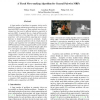Free Online Productivity Tools
i2Speak
i2Symbol
i2OCR
iTex2Img
iWeb2Print
iWeb2Shot
i2Type
iPdf2Split
iPdf2Merge
i2Bopomofo
i2Arabic
i2Style
i2Image
i2PDF
iLatex2Rtf
Sci2ools
137
click to vote
CVPR
2012
IEEE
2012
IEEE
A tiered move-making algorithm for general pairwise MRFs
A large number of problems in computer vision can be modeled as energy minimization problems in a markov random field (MRF) framework. Many methods have been developed over the years for efficient inference, especially in pairwise MRFs. In general there is a trade-off between the complexity/efficiency of the algorithm and its convergence properties, with certain problems requiring more complex inference to handle general pairwise potentials. Graphcuts based α-expansion performs well on certain classes of energies, and sequential tree reweighted message passing (TRWS) and loopy belief propagation (LBP) can be used for non-submodular cases. These methods though suffer from poor convergence and often oscillate between solutions. In this paper, we propose a tiered move making algorithm which is an iterative method. Each move to the next configuration is based on the current labeling and an optimal tiered move, where each tiered move requires one application of the dynamic programming...
| Added | 28 Sep 2012 |
| Updated | 28 Sep 2012 |
| Type | Journal |
| Year | 2012 |
| Where | CVPR |
| Authors | Vibhav Vineet, Jonathan Warrell, Philip H. S. Torr |
Comments (0)

